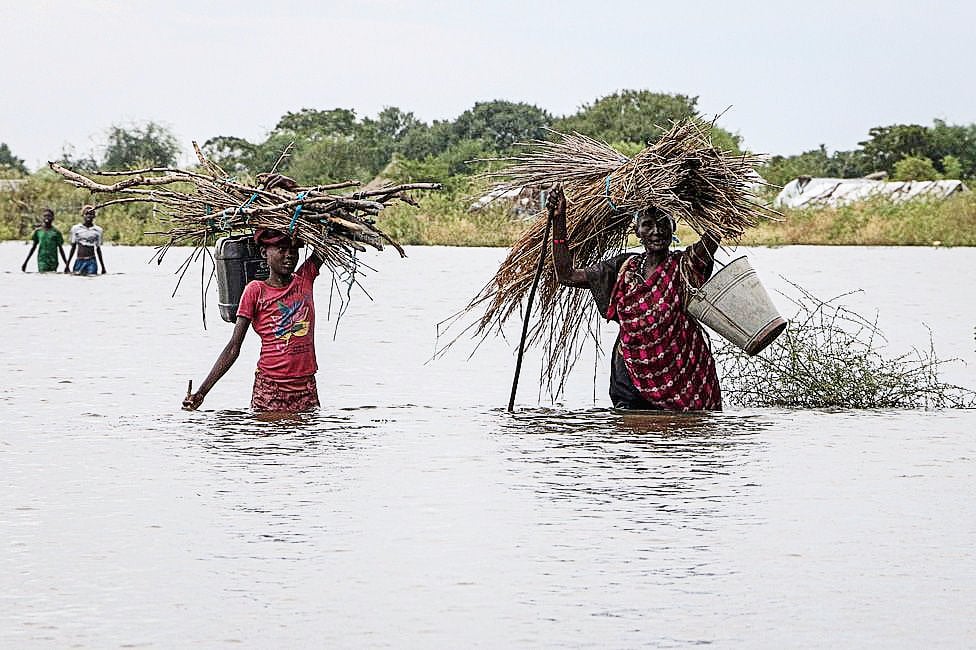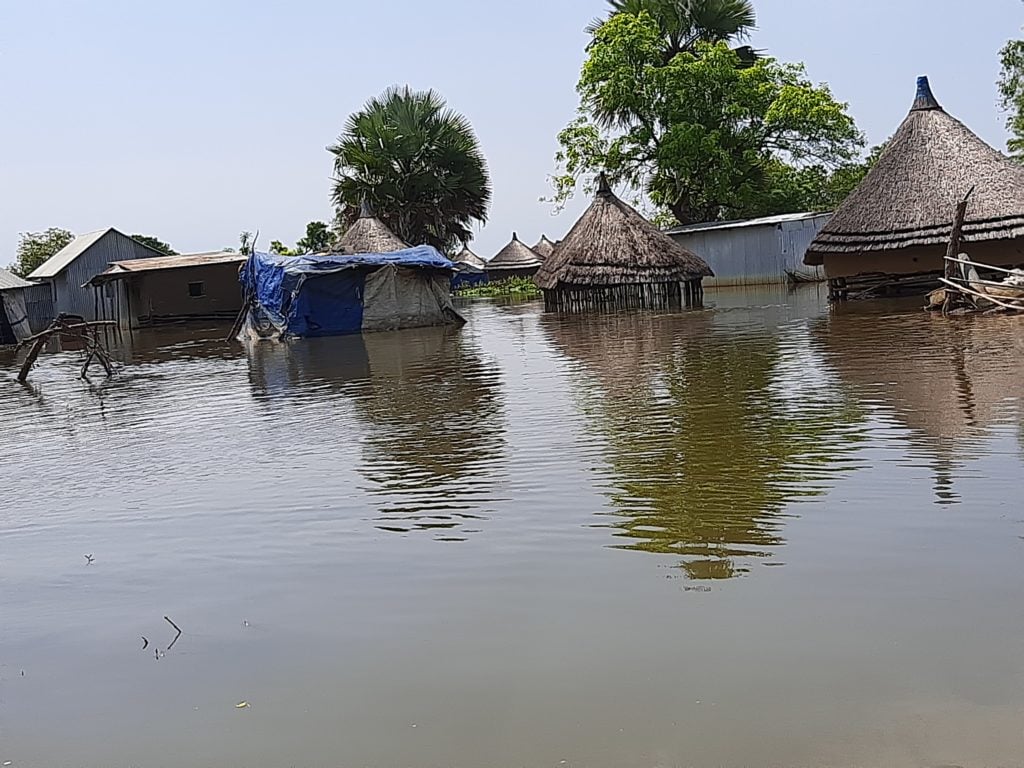Nile River floods are causing unprecedented havoc in South Sudan. Cordaid continues its humanitarian assistance to thousands of displaced and flood-affected people. “The biggest challenge is getting there”, say aid workers Bashir James and Arem Deng whose job now includes swimming.

Last week, both Arem, based in Jonglei State capital Bor, and Bashir, who works from national capital Juba, spent a few days in Kondai, one of the worst-affected sites, and a mile off the riverbanks in Bor South County. They were preparing new Cordaid response activities. “To get there, we had to swim”, says Bashir. “Getting wet wasn’t an issue. Currents and crocodiles were.”
The fact they had to swim this time, while in September and October life-saving humanitarian items for 12.000 people could still be carried out by wading through the water, shows how bad things have turned over the last weeks. “We have never seen this before”, says Arem.
Biggest floods in living memory
Too often ‘unprecedented’ is an inflated word. This time, it isn’t. “Even the elderly among the displaced we spoke to, say these floods surpass the ones of 1962”, Arem says.
“There is definitely a correlation with climate change. Weather patterns have drastically changed over the years, with extreme downpours we didn’t see before.”
The floods immediately affect over one million people in South Sudan. In Jonglei alone, the worst-affected state, they have displaced an estimated 400.000 people. More to the north, in Sudan, torrential rains had risen Nile water levels by 17.5 metres in August. Flooding destroyed millions of acres of farmland and killed innumerable cattle. For the first time in history, even the pyramids in Meroë are threatened by flooding.

“The floods are uprooting communities and families all along the Nile River and its tributaries, across the country but particularly in Jonglei State, ” says Bashir. “They seek safety and shelter in makeshift camps on higher grounds. So far, few people seem to have drowned. Luckily, most people in these areas know how to swim.”
In August and September, Cordaid rolled out a life-saving aid operation with funds from the START Network. Within a month, Bashir, Arem, and other frontline workers distributed blankets, buckets, water purifiers, hygiene items, and other essentials to 12.000 displaced persons in Kondei, near broken Nile banks and river levees.
Cordaid continues to provide humanitarian assistance
Funds for this successful operation have now been depleted, but Cordaid continues to assist new arrivals. “With 150.000 € of Cordaid funding, we will assist 9000 newly arrived people, giving them shelter material, water purifiers, and basic hygiene items. This offers a degree of protection, also against COVID-19”, Bashir explains. “We have procured the items in Juba. This week we will distribute them among the neediest in Kondei.

Undoubtfully, this will involve not only trucks but also canoes. And most probably swimming.
Climate change correlation
When asked if and how climate change is behind all this, Arem is outspoken. “There is definitely a correlation”, he says. “Weather patterns have drastically changed over the years, with extreme downpours we didn’t see before.”
“With 150.000 € of Cordaid funding, we will assist 9000 newly arrived people, giving them shelter material, water purifiers, and basic hygiene items.”
The weather in Bor seemed fine lately, yet this is deceiving. “In Jonglei State, it didn’t rain in the last weeks, yet levels continue to rise. This is because the rivers carry the rains from Uganda and elsewhere”, Arem explains.
Recurring and increasingly extreme downpours and scorching droughts are killing the land. Water absorption capacity diminishes, leaving the land - and farmers – no time and no resources to deal adequately with the next rainy season or the next drought.
Returning to what?
“Maybe in February displaced people will return. But they return to what?”, Bashir asks. “To nothing”, he answers. “The water has submerged their villages, destroyed their fields and produce, and drowned their cattle.”
Repeatedly, Bashir underscores the need to look ahead. “We know the floods will not recede until February or March. People then have one month to return to their homes and fields. After that, the rainy season will start again.”
This leaves them insufficient time to grow anything and to secure food production. By March, people will already have depleted the very few reserves they had because they had to cope with the current crisis. There will be little leeway to cope with the next one.
Floods destroy drinking water infrastructure
Water can destroy water. In South Sudan, as in any flooded part of the world, this is an all too painful truth. “Drinking water sources are also submerged”, Bashir explains. Even when groundwater levels hopefully drop soon, they remain contaminated and dysfunctional.
“For now, we provide water purifiers. These allow people to safely drink surface water. But in the longer term, water, housing, farming infrastructures need to be restored”, Bashir continues. “Providing life-saving assistance is our first concern now. But soon, we need to focus on longer-term rehabilitation. This is the responsibility of the government and the whole humanitarian arena of which Cordaid is part.”

As to rehabilitation, displaced people and residential communities themselves were the first to act. “In Kondei, they had practically restored the broken river levee in September themselves”, Arem says. “Then, the water caught up with them. In October, the levee was underwater, just like so much else of the buildings and constructions”, he continues.
“We are simply overwhelmed. In Jonglei State, the epicentre of the crisis, only three international relief agencies are responding. Cordaid is one of them.”
Bashir James
Meanwhile, the government and the United Nations Mission in South Sudan (UNMISS) are constructing secondary dykes to halt the water.
Fewer aid workers, bigger challenges
Humanitarian access is obviously one of the biggest challenges for aid workers. But there are others. Globally, funding for humanitarian assistance has been decreasing in the past years. On top of that, the COVID-19 pandemic pushes western countries to provide even less assistance, making a perfect storm for the world’s most vulnerable. As resources are dwindling and crises are increasing, there are fewer aid workers on the ground facing bigger challenges.
“We are simply overwhelmed”, says Bashir. “The floods affect over a million people in South Sudan. In Jonglei State, the epicentre of the crisis, only three international relief agencies are responding. Cordaid is one of them. Staff and resources are lacking. And if we, the aid workers who go back and forth, are overwhelmed, just imagine what it’s like for the families we are reaching out to”, he concludes.
Read more about Cordaid in South Sudan. Or about Cordaid’s humanitarian aid.